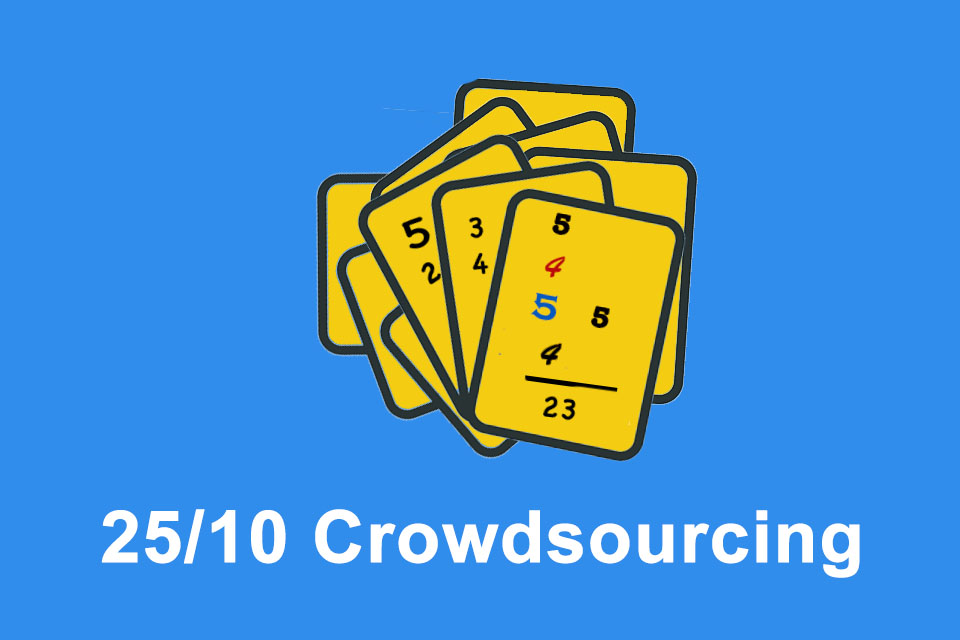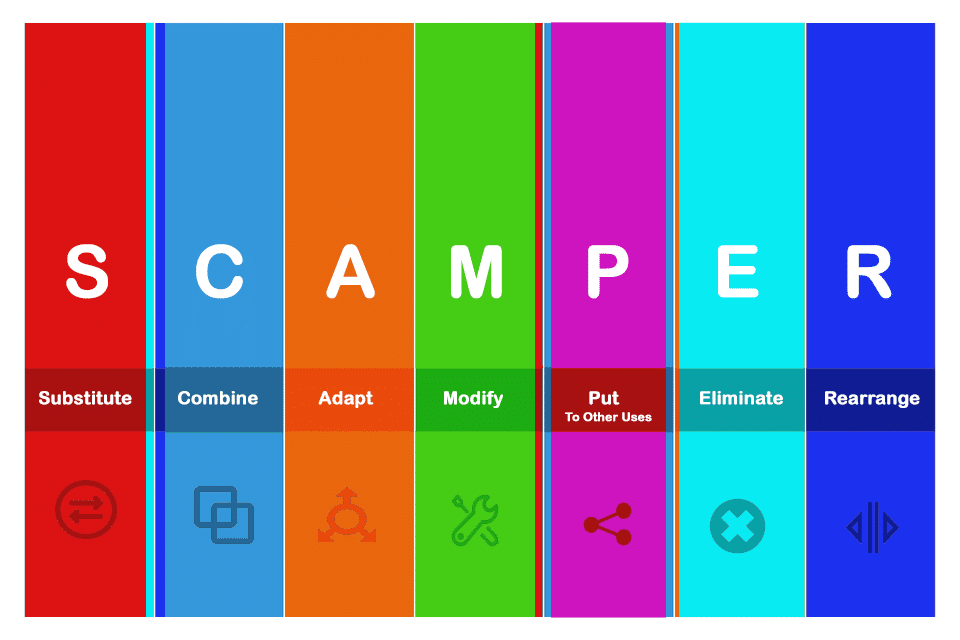What is 25/10 Crowdsourcing?
Smartpedia: 25/10 Crowdsourcing is a so-called microstructure of Liberating Structures that enables the collective collection, screening and evaluation of ideas.
25/10 Crowdsourcing – collecting 10 top ideas
The Liberating Structures offer a toolbox of 33 so-called microstructures. 25/10 Crowdsourcing¹ is one such microstructure that promotes the collection, sifting and prioritisation of ideas from a group in a short time.
What does 25/10 Crowdsourcing stand for?
- 25 stands for the maximum number of points possible in the evaluation of ideas. Five points can be awarded per idea in five evaluation rounds. 5 x 5 = 25.
- 10 stands for Top 10 and thus for the numerical goal of identifying 10 particularly good ideas.
- And crowdsourcing refers to the contextual, punctual, temporary and targeted interaction of companies with a large number of people (crowd) to procure knowledge (sourcing).
The process of 25/10 Crowdsourcing
Ideally, the facilitator explains the rules and the procedure at the beginning. If necessary, he or she initiates a test run. Once all participants have understood the procedure and the rules, the process can begin:
- The facilitator names a concrete situation and formulates a clear question or challenge. They are looking for “bold” ideas! If necessary, the facilitator can document these ideas in a way that is permanently visible to all participants, e.g. on a whiteboard.
- All participants are given 5 minutes to document a bold idea and the first step towards implementing this idea on an index card.
After each participant has written down their idea and the first step towards implementation, the facilitator gives a signal and the participants start to wander around, exchanging the idea cards among themselves and reading through the ideas silently and for themselves. Ideally, each participant holds only one card at a time, and after reading it, passes it on to another person. After about 3 minutes, the facilitator ends the swap, read, swap by signal. - Now each participant rates the idea on the back of the index card. 1 point stands for low, 5 points for high.
- The facilitator rings the bell for the next round and the swap, read, swap starts again, followed by the next round of evaluation. In total, 5 rounds are played through.
- After the 5 rounds, each participant adds up the points of the card they are currently holding. And the facilitator starts the search for the top 10 ideas by first asking: “Who has a 25?”, and then “Who has a 24?” etc.
Tips for conducting 25/10 Crowdsourcing
There are a few tips that can help when conducting the microstructure:
- Look for particularly “bold” or “daring” ideas. Sketching out the first step towards implementation automatically creates a natural connection to reality.
- Participants should make sure that they do not accidentally evaluate an idea more than once. Should this be the case, it is advisable to suspend an evaluation round. Consequently, the correspondingly affected idea card can only receive a maximum of 20 points, so when adding up the values, the average of the documented values should be calculated first and then multiplied by 5.
- The facilitator can encourage dialogue during the exchange rounds so that an exchange about individual ideas and the steps towards implementation becomes possible. For example, “How do you understand this idea?” encourages conversation about a concrete idea. Ideally, such dialogue should take place as quietly as possible.
- The fun factor in 25/10 Crowdsourcing can easily be increased by using “funny” point scales. For example, 1 could be for “the moon is more likely to fall to earth” and 5 for “there’s an Oscar for that”.
- Collecting the top 10 is a central goal, but ideas outside the top 10 can also provide valuable input. Here, the conscious examination of individual ideas can unearth hidden treasures. Ideally, therefore, all ideas should be placed on the whiteboard or pinboard in a defined order.
- Collecting the ideas is a first step. After this step, the participants should focus on the top 10 and discuss and concretise the steps for implementation in more detail.
25/10 Crowdsourcing as a method is also suitable for areas beyond ideation. For example, impediments can be identified (“What hinders you in your activities?”), enthusiasm factors can be gathered (“What feature should our product have so that everyone wants it?”) or changes can be initiated (“If you had one wish, what would you wish for or from our company?”).
Criticism of 25/10 Crowdsourcing
Collecting and evaluating bold ideas together is certainly a useful endeavour. Nevertheless, there are some points about 25/10 Crowdsourcing that can be understood as a critique of the microstructure:
- Crowdsourcing is intrinsically about a company’s interaction with a large crowd of people external to the company (crowd) to acquire knowledge (sourcing). Certainly, the approach is suitable for a large two-digit number of participants, possibly also for a three-digit number, but not for several thousands or even hundreds of thousands of participants. And the input from outside is also missing, as the participants are often company employees and not people from outside the company. Perhaps the term “self-sourcing” is more appropriate?
- In contrast to other methods of brainstorming, such as brainwriting, there is a lack of mutual inspiration and further development of ideas. If an idea is not sketched within the first 5 minutes, it falls under the table.
- Since the points are awarded successively, it cannot be ruled out that the points awarded in the previous rounds influence the current points awarded. A sometimes recommended “covering” of the scores is not really practical.
- Dialogue between idea-sharing participants is certainly useful, but is 25/10 Crowdsourcing better than other methods of idea generation? Perhaps better results can be achieved with 1-2-4-All?
- The method itself does not offer any additional support for idea generation. Other methods such as SCAMPER or Starbursting support the finding of ideas by explicitly asking.
Opinions vary, by the way, in assessing whether the approach is beneficial for introverts. On the one hand, documentation and evaluation take place in a quiet, relaxed atmosphere, but on the other hand, the steps for implementation have to be discussed together. Moreover, it is not easy for some people to develop ideas at the push of a button or to stop dealing with ideas at the push of a button. Here it might be useful to communicate the topic in advance of the idea generation.
Impulse to discuss
How useful is it to continuously try out new methods in the course of ideation?
Notes:
If you like the article or would like to discuss it, please feel free to share it in your network. And if you have any comments, please do not hesitate to send us a message.
[1] Crowd Sourcing is the spelling used on the Liberating Structures website.
Shaping the new togetherness describes the practical application of 25/10 Crowdsourcing.
Here you can find a video showing a 25/10 Crowdsourcing with 80 participants in fast motion.
And here you will find additional information from our Smartpedia section:



